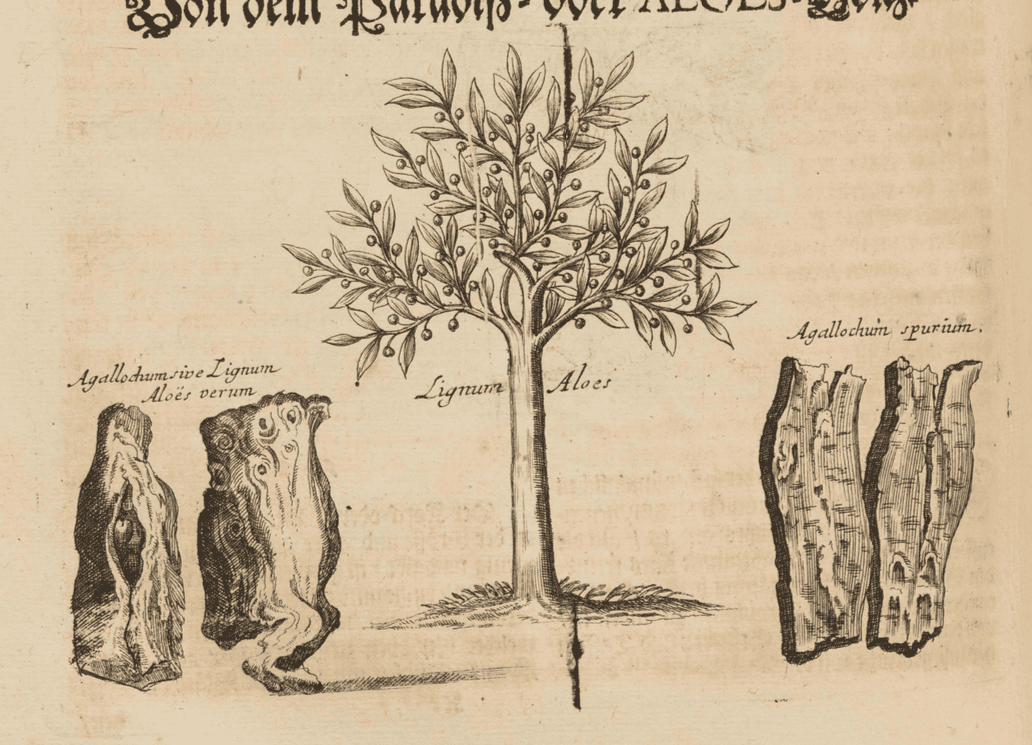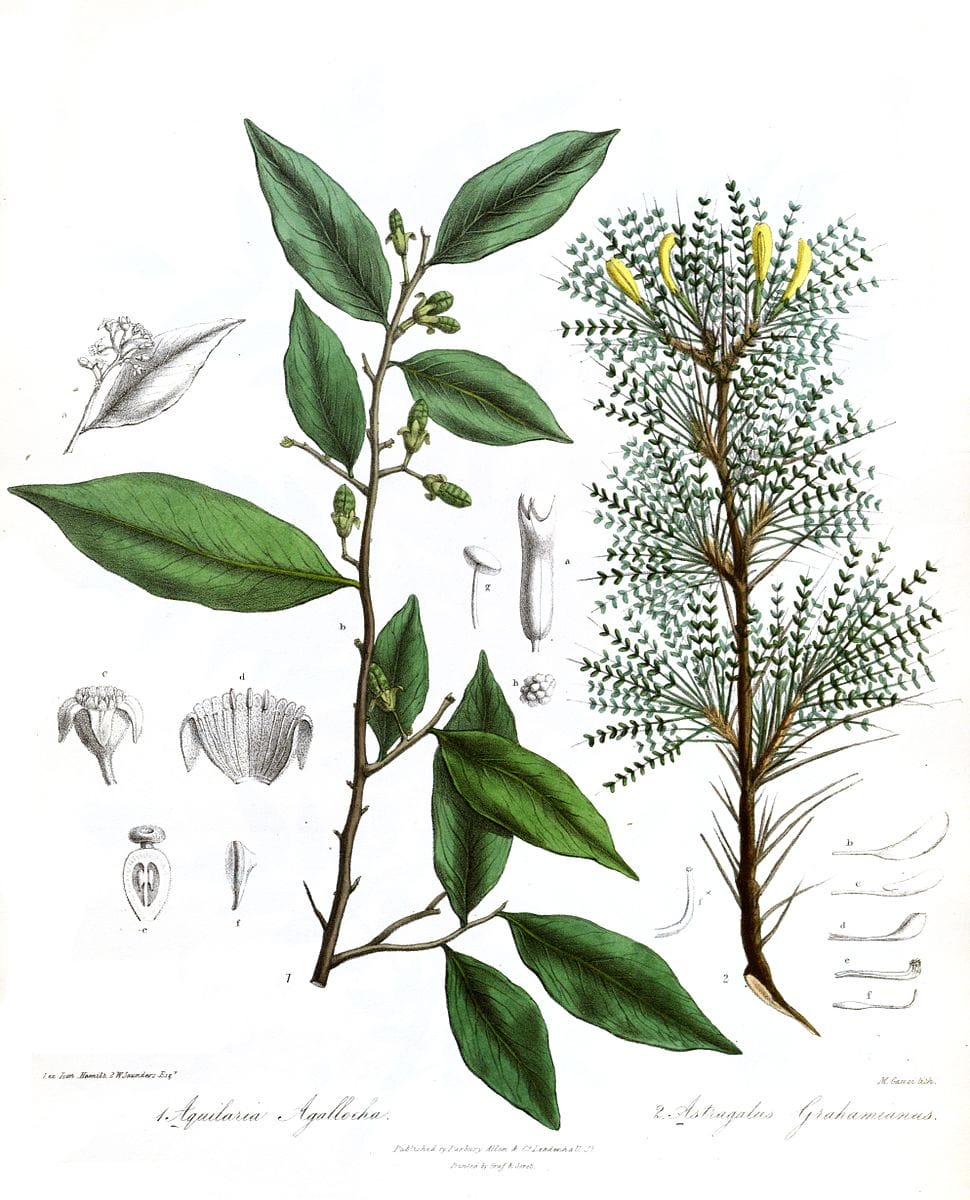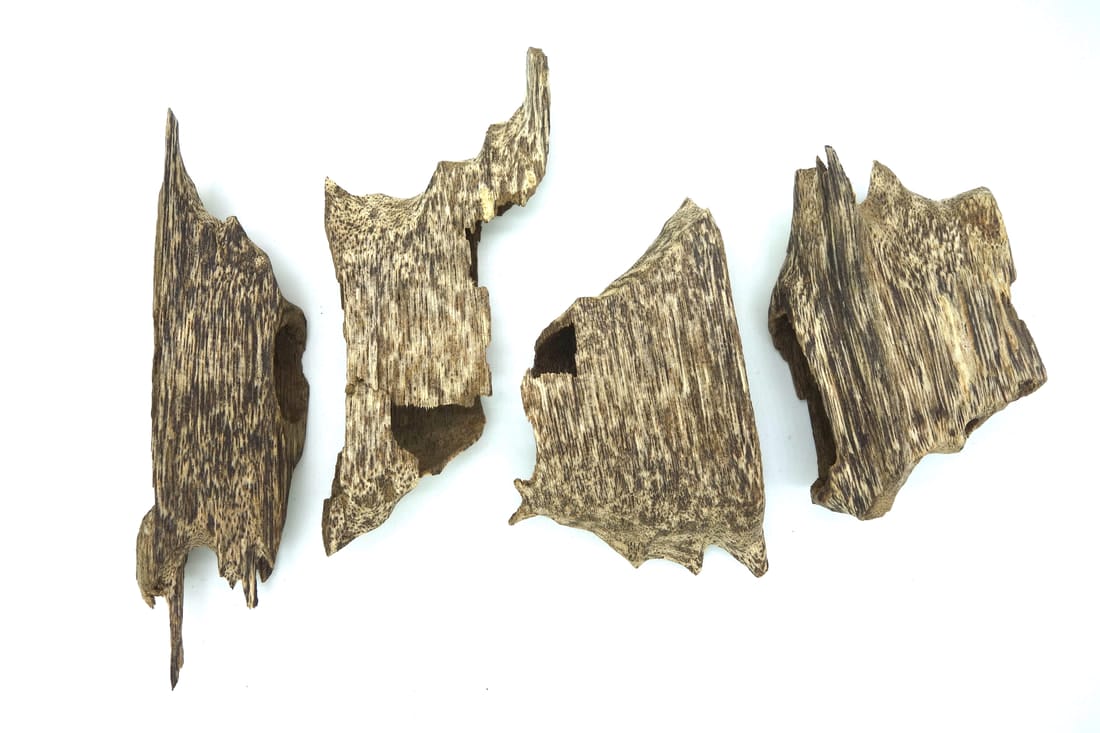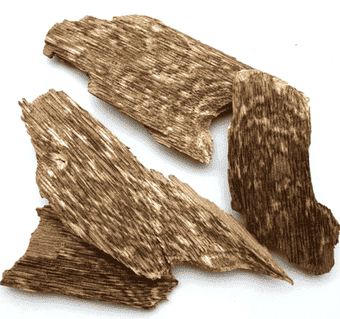Aquilaria, Aloeswood, Chen Xiang 沉香Eaglewood, Agar, Agarwood, Aloes Wood, Wood of AloesChen Xiang (TCM) Agaru (Ayurveda) A gar ཨ་གར (Tibetan) Ood, Ood Hindi, Ood-ul Hindi, Ood Gharqi (Unani) |

|

 Left: True Aloeswood; Center: Aloeswood tree; Right: ‘Spurious’ (false) Aloeswood
Left: True Aloeswood; Center: Aloeswood tree; Right: ‘Spurious’ (false) AloeswoodMuseum Museorum, Valentini, 1704
 A. agallocha (left)
A. agallocha (left)Royle, J.F., Illustrations of the botany and other branches of the natural
history of the Himalayan Mountains and of the flora of Cashmere, (1839)

|

|
Botanical name:
Various species of Aquilaria:
- A. aqallocha is the standard product
- A. malaccensis (regarded as best)
- A. sinensis
- A. crassna
- A. secundaria
- A. ovata
- A skya, (Agar dkar po): Aquilaria sinensis
- Ar nag (Agar ru nag po) Aquilaria agallocha
- Ar dmar (Agar ru dmar po, A gar dmar po, Agar go snoyd) Cinnamomum parthenoxylon, C. impressinervium, C. granduliferum
Additional sources:
1. Members of the genus Gyrinops (of which there are 8 species) were originally classed as Aquilaria, and are also sources of ‘Agarwood’
2. Excoecaria agallocha has also been listed as a source of Agarwood.
3. Aetoxylon sympetalum is the source of ‘White Agarwood’, primarily used in perfumery, but also reportedly a source of ‘Agarwood’.
The microbes identified in Aloeswood samples include Aspergillus, Lasiodiploidia, Chaetomium, Fusarium and Penicillium.
Parts used:
The Wood is infected with fungii.
Infected wood produces a resin which collects in rotten hollows in the Wood. The best quality was the near pure resin collected from the hollows which is now near unobtainable on the market. Next quality is wood with greater or lesser amounts of black or purplish streaking from the resin as shown above. The poorest quality is wood from the Aquilaria tree that has little or no resin.
‘The best Aloeswood sinks into water’ (Avicenna). This was noted in Chinese, Indian and Tibetan texts too. However, this is only seen in heavy, resin-rich wood. The majority of Aloeswood on the market today is very light, speckled with resin.
Temperature & Taste:
Warm, dry. Pungent, Bitter, Aromatic
“Hot and dry in the second degree.” (Avicenna)
“Chew the drug to find its quality: If it is sweet and fragrant, it is a drug of plain [neutral] quality. If it tastes pungent, it is a drug of Hot quality”. (Li Shi Zhen).
Classification:
2B ATTENUATERS. 2H. CARMINATIVES. 2S. STRENGTHENING MEDICINES
3D. CORDIALS & CARDIACS. 3F. LITHONTRIPTIC
4a. CEPHALIC. 4c. CARDIAC. 4e. STOMACHIC. 4g. HEPATIC
Uses:
1. Regulates the Qi, Settles Wind, Calms the Mind:
-important medicine for all types of Qi and Wind disorders; it regulates Qi
-diseases of the “Life Channel” (Du Mai) (Tibetan Medicine)
-Hypertension, Dizziness, Vertigo
-Insanity, Nervous and Mental disorders as well as Melancholy (West, Tibetan Medicine)
–’It comforts the Brain and Animal Faculty’ (Salmon)
-‘Strengthens the Senses’. (Avicenna)
-“It strengthens the nerves and is useful for them by its oiliness and tenuous viscosity”. (Avicenna)
-‘It clears the Mind and keeps one in good mental condition’. (Ben Cao Gang Mu)
2. Moves Qi, Strengthens the Heart:
–strengthens the Heart and makes it cheerful’. (Avicenna)
-‘Fortifies the Heart, cheers the Spirits’. (Salmon)
-Palpitations, Chest tightness
-Exhilarant (Unani)
-protects the Heart in Fevers.
-used when Wind enters the Heart (Tibetan Medicine)
3. Warms the Digestion, Moves the Qi, Eases Pain:
-distention or pain in the epigastric or abdominal area;
-vomiting, belching, hiccoughs from a Cold and weak stomach and spleen.
-abdominal pain due to internal bruising, stagnant Blood and Tumors
–‘A Great strengthener to the Stomach’ (Culpeper); some older TCM texts said it ‘Tonifies the Spleen‘.
–’removes Putrid Moisture from the Stomach’. (Avicenna)
-“It dissolves hard mass in the abdomen”. (Da Ming)
4. Strengthens the Lungs and Kidneys, Stops Wheezing:
-Asthma and Wheezing from weakness especially if with Kidney weakness.
-tightness of the Chest, Emphysema and Pleurisy.
-Tumors of the chest.
-deficiency and weakness of the Waist and Knees (TCM).
-Catarrh in the West; used for Rhinitis and Sinusitis (Ayurveda, Tibetan Medicine).
5. Guides the Qi down:
-special effect in guiding Qi down, and guiding Yang back to its base (lower body)
-it can warm and strengthen the Yang without allowing excess Yang Qi to move upwards to the head.
–good for Heat in the Upper body and Cold in the Lower body. (Li Shi Zhen)
-Rising Qi can cause Asthma, as well as Vomiting, Belching, and Hiccoughs.
-“It is a drug of Yang with a tendency of both ascending and descending”. (Zhang Yuan Su)
6. Benefits Qi and Yang:
-Lethargy, Dullness
-warms and strengthens the Brain, Heart, Liver and Stomach (West, Unani)
-“Strengthens the Viscera and protects the organs from the flow of infiltrating matter towards them”. (Avicenna)
–‘Strengthens the Brain and Whole Body’. (Schroder)
-‘It Strengthens the Whole Body and Restores in Consumptions’ (Salmon)
-‘Invigorates the 5 Viscera’, ‘Replenishes the Vital Essence’, and ‘Reinforces the Yang’ (Ben Cao Gang Mu)
-“It harmonizes the interior and tonifies the Five Viscera. It reinforces Jing”. (Da Ming)
-considered Rasayana and strength-promoting in Ayurveda.
-traditionally used as an Aphrodisiac in the East.
Dose:
250mg–1 ½ grams, usually in Pills or Powders.
If decocted it is added at the end, but it is best to take the powder with decoction.
Correctives:
1. Camphor
2. Rose (Unani)
Substitute:
Aloeswood is costly, rare, endangered, and often adulterated.
1. Sandalwood can generally be used for it, but is not as strong: Renodeus (1657) said ‘… if Aloeswood cannot be had, Citrian Santals [Yellow Sandalwood] may be substituted’. Sandalwood is an accepted substitute in both East and West.
2. Cassia Wood, Saffron, Mastic (either alone, or in combination) (Unani).
3. Clove, Mace (Unani)
4. In Tibetan Medicine, roots and stems of Daphne aurantiaca are called Ar nag shog shin and are used as a different source of Ar nag.
5. The wood of Cinnamomum parthenoxylon is also used as a source of A nag in Tibetan Medicine.
6. In Russia, Tibetans also used irregular masses growing on the trunk of the Larch tree; leaves of Ba lu dkar po (type of Rhododendron) have also reportedly been used as a substitute
7. Ebony wood (Diospyros) has apparently been used in Dharamsala.
8. In Mongolia, Caryopteris mongolica has been used as a substitute.
9. Buryat tradition uses Cypress wood
Note:
1. Aloeswood is a special medicine. It guides Qi downward and leads the Yang Qi back to its base in the lower abdomen. It moves and regulates Qi yet doesn’t disperse Qi. This is why in classical formulas, especially of Tibetan Medicine, it is an important herb for Qi stagnation and Wind disorders.
2. Traditional texts of both East and West regarded it as strengthening to the principal organs.
3. ‘warm without being drying, promotes movement without draining, supports the Spleen so that transportation is not fatigued, and reaches the Kidneys to guide fire back to its base. Its action in directing downward does not break up the qi and [thereby] cause harm. It is truly a fine substance’. (Penetrating the Mysteries of the Materia Medica, out of Bensky)
4. ‘The aloe wood is obtained from the branches and roots of trees. After cutting off from the trees, the material is buried in the earth till its wood and pitch is putrefied’. (Avicenna) This suggests wood was buried to allow the fungii to grow.
Main Combinations:
1. To strengthens the Heart and Brain, moves the Qi, opens the Orifices, and frees the Qi and Spirit from oppression, Aloeswood with Ambergris and Musk (as in Gallia Moscahata). Often added to larger formulas.
2. To strengthen the Heart, Stomach and Liver, and move Qi, Aloeswood with Rose, Mastic, Cinnamon, Indian Spikenard, Cardamon and Citron peel (as in Troches of Aloeswood)
3. Wind (Qi Stagnation) affecting the Heart (distention in the chest, poor concentration, dullness, insanity etc.):
i. Aloeswood, Calamus (Shi Chang Pu), dry-fried Paeonia Bai Shao, dry-fried Coptis Huang Lian, Schisandra Wu Wei Zi, calcined Oyster Shell (The Formulas of Dr. John H.F. Shen)
ii. Aloeswood, Calamus (Shi Chang Pu), Ligusticum Chuan Xiong, Curcuma Yu Jin, Polygala Yuan Zhi
iii. Aloeswood with Nutmeg, Tabasheer, Costus, Chebulic Myrobalan and Frankincense (as in Aloeswood 8 of Tibetan Medicine)
4. Heart and Lung Fire with Palpitations and shortness of Breath, Aloeswood with Sandalwood, Safflower, Nutmeg, Tabasheer, Glehnia Sha Shen (as in Aloeswood Clear the Heart 8 Powder)
5. More severe Wind symptoms (including trembling, parkinsonism, numb extremities, paralysis) to the preceding add Sandalwood, Bezoar, Saffron, Pearl, Nux vomica
6. Cold and Moist diseases of the Brain:
i. Aloeswood (1 dram), Sugar (6 drams), take some every morning
ii. Aloeswood (2 scruples), Aromaticum Rosatum, Conserve of Betony, of Rosemary (each ½ oz)
7. Melancholy:
i. Aloeswood with Balm, Saffron, Pearl
ii. Aloeswood with Clove, Cardamon, Rose, Borage, Almond, Aniseed, Fennel seed, Saffron and Pearl
8. Cold Stomach Pain, Aloeswood with Cinnamon and Ginger or Galangal
9. Abdominal distention and fullness, fullness and shortness of Breath, Aloeswood, Cyperus rotundus Xiang Fu (stir-fried), Amomum Sha Ren, Licorice (as in Chen Xiang Jiang Qi Wan)
10. Hernia, Bloating, Aloeswood with Fennel seed for Hernia and bloating
11. Retention of Urine and urinary difficulty from Cold, Damp and Qi stagnation, Aloeswood with Costus. This is also good for Cold and stagnation in the intestines or chest.
12. Phlegm-Heat attacking the Lungs with Cough, Wheezing and chronic Bronchitis, Aloeswood, Pinellia Ban Xia, Coptis Huang Lian, Costus Mu Xiang, powdered and made into pills with Licorice decoction. (as in Chen Xiang Hua Tan Wan)
12. Asthma, Aloeswood has been combined with Radish seed in TCM.
Major Formulas:
Powder of Aloeswood (Mesue)
Powder for Vertigo
Aloeswood Powder for Palpitations
Magisterial Imperial Pills
Pills for Catarrh
Species Nere
Troches of Aloeswood (Trochisci Aquilaria) (Mesue)
Confection of Aloeswood (Unani)
Electuary of Aloeswood (Diaxyloaloes) (Mesue)
Electuary of Aloeswood of Avicenna
Electuary of Aloeswood (Egyptian?)
Electuary of Aloeswood (Persica)
Electuary of Socrates
Letificans Electuary (Unani)
Letificans Cooling Electuary (Unani)
Medicine to Defend the Base from all Danger
Tincture of Life (Mynsichts)
Gun Tan Wan
Hui Chun Dan
Chen Xiang Hua Tan Wan
Chen Xiang Jiang Qi Tang
Zhen Zhu Mu Wan
Aloeswood 6 (A gar drug pa) (Tibetan)
Aloeswood 8 (A gar brgyad pa) (Tibetan)
Aloeswood 8 Water Transformer (Ar brgyad chu bsgyur) (Tibetan)
Aloeswood 9 (A gar dgu pa) (Tibetan)
Aloeswood 10 (A gar bcu pa) (Tibetan)
Aloeswood 11 (A gar bcu gcig) (Tibetan)
Aloeswood 15 (A gar bcu lnga) (Tibetan)
Aloeswood 17 (A gar bcu bdun) (Tibetan)
Aloeswood 18 (A gar bcu bdun) (Tibetan)
Aloeswood 20 (A gar nyi shu) (Tibetan)
Aloeswood 31 (A gar so gcig) (Tibetan)
Aloeswood 35 (A gar so lnga) (Tibetan)
Aloeswood Clear the Heart 8 Powder (Tibetan)
Aloeswood Clear Wind 8 (Rlung gi a gar brgyad pa) (Tibetan)
Asafetida 8 (Shing kun brgyad pa) (Tibetan)
Calm the Shocked Mind 20 Pills (Mogolian)
Cantharide 37 (Byang chos so bdun) (Tibetan)
Life Holding Jewel (Srog ‘dzin nor bu) (Tibetan)
Notopterygium 29 Pills (Spru nag nyer dgu) (Tibetan)
Nutmeg 14 (Dza ti bcu bzhi) (Tibetan)
Nux Vomica 15 (Ko byi bcu lnga) (Tibetan)
Rhododendron 16 (Dwa lis bcu drug) (Tibetan)
Rhododendron 18 (Dwa lis bco brgyad) (Tibetan)
Supreme 25 (Bla med nyer lnga) (Tibetan)
Undying Aloeswood 8 (Chi med a gar brgyad pa) (Tibetan)
Cautions:
1. In TCM texts it was forbidden to use it for Fire from Yin deficiency. However, with appropriate herbs, it can help lead the fire down while other herbs nourish Yin.
2. According to some Unani texts, long-term use can harm the vessels.
CITES listing
Several species of Aquilaria, notably A. malaccensis, are listed as critically endangered due to overharvesting. Only around 5% of wild Aquilaria trees are infected with fungii that promote formation of Aloeswood resin, with as little as 2% having enough infected wood to be viable. Yet the illicit harvesting is massive felling all wild Aloeswood trees in a desperate search for the precious wood. The demand is huge with a global trade of around $2 billion which is rapidly growing. It is used in incense and perfumery, as well as in medicine. It is not only prized in Asia, but has a strong market in the Middle East while its popularity in the West is rapidly growing.
Thankfully farmed material is available with a number of large farms producing a high grade product in Vietnam, Cambodia, Indonesia, Thailand, Australia and elsewhere.
Main Preparations used:
Extract, compound Troches, and Compound Powder were commonly used
1. Tincture of Aloeswood:
i. Aloeswood rasped (1 part), concentrated Alcohol (12 parts). Macerate and filter. Dose: 20–40 drops. (Pharmacopoeia Hispana, 1798)
2. Extract of Aloeswood:
i. Aloeswood (any quantity), concentrated Alcohol (sufficient to exhaust the wood completely). Evaporate the tincture in a water-bath.
Dose: 1–2 grains. (Dispensatorium medico pharmaceuticum Palatinatus, 1764)
3. Sala’s Extract of Aloeswood
Aloes Wood 1 lb.
Spirit of Wine 6 lbs.
Digest 3 days in B.M.; then decant and add 1 lb. of Rose Water; then abstract with a gentle heat, washing and drying the Extract and form into Troches.
Dose: 4-10 grains
|
‘The use of this precious wood as a perfume and medicine is of great antiquity. Together with myrrh, cassia, and other products of the East, it is mentioned in the sacred writings of the Jews (Num. 24, 6; Psalm. 45, 8 ; Prop. 7,17; Cantic .4,14) under the name of Ahalotor Ahalim. It is the [?] of the ancient Greeks, which is described by Dioscorides as a wood brought from India and Arabia. Later writers, from Aetius‘ time, call it [?]; or “aloe wood,” the name by which it is still known in Europe. The same substance is the Agaru of the Hindus, the Garu of the Malays, and the Chin-heang of the Chinese. In Sanskrit medical works it bears the synonyms of Raj arha “worthy of a prince,” Visva-rupa “taking all forms,” Krimi-ja “produced by worms,” Krimi-jagdha, Anarya-ja “produced in a non-Aryan country,” Kanaka “golden,” Kaliya “black,” &c, and is described as hot, light, and cholagogue; removing diseases of the ear, nose and eyes. In native practice Agar is used as a deobstruent, stimulant, carminative, and tonic; it is said to relieve the pain in gout, and to check vomiting. Susruta directs Aguru, Guggula, Sarjarasa, Vacha, white mustard, Nim leaves and salt to be made into a paste with ghee to form an anodyne fumigation for surgical wounds, called in Sanskrit VedanurakHhoghnairdhupaih. As aloe wood bears the Sanskrit name of Anarya-ja, it is probable that it was used by the aborigines of Eastern Asia before it became known to the Hindus, but that at a very early date it was carried overland to Central Asia and Persia, and from thence reached Arabia and Europe. The early Arab travellers appear to have collected a good deal of information concerning the commerce and sources of supply of the wood. Yohanna-bin-Serapion mentions four kinds, Hindi, Mandali, Sinfi and Kamari, and Ibn Sina in the 10th century has the following account of it:—”The best is called Mandali from the more central parts of India; next is the Indian [or Hill aloe wood, which has the advantage over Mandali of preserving clothes from lice. Some say that Mandali and Indian aloe wood are the same. One of the best kinds is Samanduri from Sofala in India; again there is the Kamari and the Samfi from the same parts, and there is Kakuli, and Kismuri which is moist and sweet; and the worst kinds are Halai, Kamtai, Mabatai, Lancathi, or Rabatathi. Mandali is the best; then Samanddri, of a grey colour, fat and oily, heavy, without any white streaks, and which burns slowly. Some consider black aloe wood better than grey, and the best black is the Kamari, without white streaks, fat and oily, which burns slowly. In short, the best aloe wood is black, hard, and heavy, sinks in water, is not fibrous when powdered; that which does not sink is bad. The tree is said to be buried to promote the formation of aloe wood. The Arabian travellers give much the same names to different kinds of the wood. Ibn Batuta speaks of Kamari as soft, like wax. Abu Zaid calls it Kamariini, and says it is the best kind. Abulfeda states that it comes from the Kamarun Mountains. Kakuliis said to derive its name from Kakaleh in Java. The epithets Mawardi, Saimuri and Jawi are also applied by some writers to aloe wood. As regards the identification of these localities, we would remark that Samfi is probably derived from Champa, a province in Cambodia; Mandali, from Mount Mandar or Mandal, south of the modern town of Bhagalpur in Bengal; Kamari or Kamariini, from Kamarun, the Arab name for Cape Comorin; Saimuri, from Saimur or Samar, an island in the Eastern Archipelago; Halai may possibly be derived from the Hala Mountains between Sind and Beluchistan, as Abu Zaid says that the best aloe wood is brought for sale by Multanis. Haji Zein-el-Attar (1368) calls aloe wood Ood-el-juj, and in Persian, Ood and Balanjuj. After translating Ibn Sina’s article on Ood, he gives his own opinion in the following terms : “The author of this work (Ikhtiarat-i-badiaa) says the best is called Kalambak, and comes from the port of Jena, which is ten days’ |
sail from Java; it is sold for its weight in gold; you would think it odourless, but when warmed in the hand it has a very sweet persistent odour; when burnt, the odour is uniformly sweet until the wood is consumed. Next is Mandali and Samanduri, both from Sofala in India, the best of these is of a golden colour and heavy. Kakuli is like the Indian, and is generally in large pieces, marked with black and yellow lines; then there is Kamari, golden-brown, without white streaks, it comes from Kamarun and Sofala; then Samfi, from Samp, it is very hard and sweet; then Sakali and Afasi, a moist kind from China; then Mantai, Bandi, Halai, and Lanfi, all of about equal value. And in Manta there is a tribe who call the wood Ashbah, and it is of two kinds:one of these is in large pieces weighing from 5 to 50 maunds, without much odour, and used for making combs, knife handles, &c. Mir Muhammad Husain (1770) writes:— “Ood, in Hindi Agar, is the wood of a tree which grows in the Jaintiya hills near Sylhet, a dependency of the Subah of Bengal, situated towards the north-east of Bengal Proper. The tree is also found in the islands to the south of Bengal, situated north of the Equator, and in the Chatian islands belonging to the town of Nawaka, near the boundaries of China. The tree is very large, the stem and branches generally crooked, the wood soft. From the wood are manufactured walking sticks, cups, and other vessels; it is liable to decay, and the diseased part then becomes infiltrated with an odoriferous secretion. In order to expedite this change it is often buried in wet ground. Parts which have undergone the change above mentioned become oily, heavy, and black. They are cut out and tested by being thrown into water; those which sink are called Gharki, those which partly sink Nim Gharki, or Samaleh-i-aala, and those which float Samalch; the last kind is much the most common. Gharki is of a black colour, and the other qualities dark and light- brown.” The best kind for medicinal use is Gharki Ood from Sylhet; it should be bitter, odoriferous, oily and a little astringent; other kinds are considered inferior. In most receipts raw Ood (Ood-i-kham) is enjoined to be used to prevent the use of wood from which the oil has been abstracted by crushing and mace ration in water, or by crushing and admixture with almonds, which are afterwards expressed. This precaution is the more necessary as Ood shavings are an article of commerce in India under the name of Ghura agar; they are often adulterated with chips of Sandalwood, or Taggar, an odoriferous wood, common in India. Rumphius describes two kinds of true, and two of false, aloe wood; the first kind of true aloe wood, he says, is called Kilam or Ho-Kilam by the Chinese, and Calambac by the Malays, and is produced by a tree growing in the provinces of Champa and Coinam, and in Cochin-China. This tree has been described by Loureiro under the name of Aloexylon Agallochum. The second kind, called Garo, is the product of Aquilaria malaccemis, Lamk., which he figures. This is the Chin-heang of the Pun-tsaou-kang-muh or great Chinese Herbal. (See Hanbury Science Papers, p.263.) His two kinds of false aloe wood he attributes to Michelia Champaca and Exccecaria, Agallocha. Roxburgh and other botanists have examined the Aquilaria in Sylhet, and recently an Aquilaria has been ascertained to be the tree which produces aloe wood in the islands of the Mergui Archipelago. Gamble says that “Akyau (the Burmese name for aloe wood) is the most important produce of the forests of South Tenasserim and the Mergui Archipelago. It is found in fragments of various shapes and sizes in the center of the tree, and usually, if not always, where some former injury has been received.” Aloe wood is used throughout the East as an incense and as a perfume, and was formerly used as a medicine in Europe for the same diseases for which it is still prescribed in India.’ (Pharmacographia Indica, Dymock, 1893) |
